Effect of Inoculation Treatment on Number of Primary Austenite Grains in Hypoeutectic Chromium Cast Iron: EBSD Imaging and Mathematical Structure Prediction
Abstract
1. Introduction
2. Thesis and Purpose of Work
- -
- determine the growth law of primary austenite grains as a function of supercooling, N = f (ΔT);
- -
- determine the amount of inoculant (Fe–Ti) as a function of the number of primary austenite grains, M = f (N).
3. Methodology
4. Microstructure Analysis Using EBSD Technique
4.1. Reference Cast Iron Sample
4.2. Inoculated Cast Iron (0.17 wt.% Fe-Ti)
4.3. Inoculated Cast Iron (0.33 wt.% Fe–Ti)
4.4. Inoculated Cast Iron (0.66 wt.% Fe-Ti)
5. Determination of Number of Primary Austenite Grains
- N—number of grains in area
- NW—number of whole grains in area
- NP—number of grains cut by sides of area
- NR—number of grains in corners of area
- NA—surface grain density,
- P—area, mm2
- NV—volumetric grain density,
| Sample | N | P | NA | NA | NV | NV |
|---|---|---|---|---|---|---|
| mm2 | 1/mm2 | 1/cm2 | 1/cm3 | 1/m3 | ||
| Reference | 6.5 | 17.1403 | 0.3792 | 37.92 | 132.64 | 1.33 × 108 |
| Inoc. 0.17% Fe–Ti | 22.75 | 20.1416 | 1.1295 | 112.95 | 681.84 | 6.82 × 108 |
| Inoc. 0.33% Fe–Ti | 174.5 | 27.4176 | 6.3645 | 636.45 | 9120.05 | 9.12 × 109 |
| Inoc. 0.66% Fe–Ti | 233 | 16.2031 | 14.3799 | 1437.99 | 30,973.04 | 3.10 × 1010 |
- -
- σ1,s—surface tension at liquid–solid interface,
- -
- ΔS—entropy change,
- -
- ΔT—degree of sub-cooling, K
- M—amount of inoculant, wt.%
- A and B—matching parameters
- ΔT—maximum degree of sub-cooling, K;
- Parameters C and D—adjustment parameters.
- The following values of the adjustment parameters were determined: C = 1.44 × 1011, and D = −0.31.
6. Conclusions
- Inoculation of chromium cast iron using Fe–Ti increases the number of carbides by 7%;
- Inoculation of chromium cast iron using Fe–Ti significantly increases the number of primary austenite grains;
- Research allowed us to determine an exponential function describing the effect of the addition of Fe–Ti (M) inoculant on the volume density of primary austenite grains in the following form: , m−3;
- Research allowed us to determine a relationship between the maximum degree of supercooling ΔT and the density of primary austenite grains of exponential nature in inoculated high-chromium cast iron: , m−3;
- For chrome cast iron without inoculation, the impact strength does not exceed 4 J/cm2;
- With the optimal content of the inoculant of 0.33% Fe–Ti, the impact strength of cast iron is 14.4 J/cm2
Author Contributions
Funding
Institutional Review Board Statement
Informed Consent Statement
Data Availability Statement
Acknowledgments
Conflicts of Interest
References
- SuSudhakar, A.N.; Markandeya, R.; Ajoy, K.P.; Kaushik, D. Effect of alloying elements on the microstructure and mechanical properties of high chromium white cast iron and Ni-Hard iron. Mater. Today Proc. 2022, 61, 1006–1014. [Google Scholar]
- Jena, P.S.M.; Sahu, J.K.; Rai, R.K.; Das, S.K.; Singh, R.K. Singh Influence of duplex ferritic-austenitic matrix on two body abrasive wear behaviour of high chromium white cast iron. Wear 2018, 406, 140–148. [Google Scholar] [CrossRef]
- Dojka, M.; Kondracki, M.; Studnicki, A.; Dojka, R. Crystallization process of high chromium cast iron with the addition of Ti and Sr. Arch. Foundry Eng. 2018, 18, 57–64. [Google Scholar]
- Dojka, M.; Dojka, R.; Stawarz, M.; Studnicki, A. Influence of Ti and REE on Primary Crystallization and Wear Resistance of Chromium Cast Iron. J. Mater. Eng. Perform. 2019, 28, 4002–4011. [Google Scholar] [CrossRef]
- Bedolla-Jacuinde, A.; Guerra, F.V.; Guerrero-Pastran, A.J.; Sierra-Cetina, M.A.; Valdez-Medina, S. Microstructural effect and wear performance of high chromium white cast iron modified with high boron contents. Wear 2021, 476, 203675. [Google Scholar] [CrossRef]
- Pourasiabi, H.; Gates, J.D. Effects of niobium macro-additions to high chromium white cast iron on microstructure, hardness and abrasive wear behaviour. Mater. Des. 2021, 212, 110261. [Google Scholar] [CrossRef]
- Jia, R.N.; Tu, T.Q.; Zheng, K.H.; Jiao, Z.B.; Luo, Z.C. Abrasive wear behavior of TiC-strengthened eutectic high chromium cast iron composites. Mater. Today Commun. 2021, 29, 102906. [Google Scholar] [CrossRef]
- Sanchez-Cruz, A.; Bedolla-Jacuinde, A.; Guerra, F.V.; Mejía, I. Microstructural modification of a static and dynamically solidified high chromium white cast iron alloyed with vanadium. Results Mater. 2020, 7, 100114. [Google Scholar] [CrossRef]
- Bedolla-Jacuinde, A. Microstructure of vanadium-, niobium- and titanium-alloyed high-chromium white cast irons. Int. J. Cast Met. Res. 2001, 13, 343–361. [Google Scholar] [CrossRef]
- Zhi, X.; Xing, J.; Fu, H.; Gao, Y. Effect of titanium on the as-cast microstructure of hypereutectic high chromium cast iron. Mater. Charact. 2008, 59, 1221–1226. [Google Scholar] [CrossRef]
- Bedolla-Jacuinde, A.; Correa, R.; Quezada, J.G.; Maldonado, C. Effect of titanium on the as-cast microstructure of a 16%chromium white iron. Mater. Sci. Eng. A 2005, 398, 297–308. [Google Scholar] [CrossRef]
- Bedolla-Jacuinde, A.; Aguilar, S.L.; Hernández, B. Eutectic Modification in a Low-Chromium White Cast Iron by a Mixture of Titanium, Rare Earths, and Bismuth: I. Effect on Microstructure. J. Mater. Eng. Perform. 2005, 14, 149–157. [Google Scholar] [CrossRef]
- Da Silva, A.E.; de Melo, I.N.R.; Pinheiro, I.P.; da Silva, L.P. Characterisation and machinability of high chromium hardened white cast iron with and without the addition of niobium. Wear 2020, 460, 203463. [Google Scholar] [CrossRef]
- Lv, Y.; Sun, Y.; Zhao, J.; Yu, G.; Shen, J.; Hu, S. Effect of tungsten on microstructure and properties of high chromium cast iron. Mater. Des. 2012, 39, 303–308. [Google Scholar] [CrossRef]
- Zhang, Y.; Sun, Y.F.; Guan, S.; Deng, X.; Yan, X. Effect of titanium and tungsten on the structure and properties of heat-abrasion resistant steel. Mater. Sci. Eng. A 2008, 478, 214–220. [Google Scholar] [CrossRef]
- Mousavi Anijdan, S.H.; Bahrami, A.; Varahram, N.; Davami, P. Effects of tungsten on erosion-corrosion behavior of high chromium white cast iron. Mater. Sci. Eng. A 2007, 454, 623–628. [Google Scholar] [CrossRef]
- Li, Y.; Li, P.; Wang, K.; Li, H.; Gong, M.; Tong, W. Microstructure and mechanical properties of a Mo alloyed high chromium cast iron after different heat treatments. Vacuum 2018, 156, 59–67. [Google Scholar] [CrossRef]
- Inthidech, S. Effect of repeated tempering on hardness and retained austenite of high chromium cast iron containing molybdenum. Mater. Trans. 2010, 51, 1264–1271. [Google Scholar] [CrossRef]
- Dorula, J.; Kopyciński, D.; Guzik, E.; Szczęsny, A.; Gurgul, D. The influence of undercooling ΔT on the structure and tensile strength of grey cast iron. Materials 2021, 14, 6682. [Google Scholar] [CrossRef]
- Siekaniec, D.; Kopyciński, D.; Szczęsny, A.; Guzik, E.; Tyrała, E.; Nowak, A. Effect of titanium inoculation on tribological properties of high chromium cast iron. Arch. Foundry Eng. 2017, 17, 143–146. [Google Scholar] [CrossRef][Green Version]
- Kopyciński, D.; Siekaniec, D.; Szczęsny, A.; Guzik, E.; Nowak, A. The effect of Fe−Ti inoculation on solidification, structure and mechanical properties of high chromium cast iron. Arch. Metall. Mater. 2017, 62, 2183–2187. [Google Scholar] [CrossRef]
- Siekaniec, D.; Kopyciński, D.; Guzik, E.; Tyrała, E.; Nowak, A. Effect of different inoculants on impact toughness in high chromium cast iron. Arch. Foundry Eng. 2017, 17, 85–88. [Google Scholar] [CrossRef][Green Version]
- Zhou, J. Colour metallography of cast iron. Chapter 2. China Foundry 2009, 6, 366–374. [Google Scholar]
- Döpp, R. Solidification and graphite formation in white cast iron. The Metallurgy of Cast Iron. In Proceedings of the Second International Symposium on the Metallurgy of Cast Iron, Geneva, Switzerland, 29–31 May 1974. [Google Scholar]
- Li, D.; Su, Y.; Zhang, X. Effect tempering on properties of high-Cr cast white iron. In Proceedings of the 69th World Foundry Congres, Hangzhou, China, 16–20 October 2010. [Google Scholar]
- Pasini, W.M.; Belle, M.R.; Pereira, L.; Amaral, R.F.; Barcellos, V.K. Analysis of Carbides in Multi-component Cast Iron Design Based on High Entropy Alloys Concepts. Mater. Res. Ibero Am. J. Mater. 2021, 24, e20200398. [Google Scholar] [CrossRef]
- Nayak, U.P.; Suarez, S.; Pesnel, V.; Mucklich, F.; Guitar, M.A. Load dependent microstructural evolution in an as-cast 26% Cr high chromium cast iron. Friction 2022, 10, 1258–1275. [Google Scholar] [CrossRef]
- Siekaniec, D.; Kopyciński, D. Phase analysis and crystallographic orientation of high chromium cast iron grain using EBSD technique. J. Cast. Mater. Eng. 2017, 1, 15–19. [Google Scholar] [CrossRef]
- Ohser, J.; Lorz, U. Quantitative Gefgeanalyse; DVG: Leipzig/Stuttgart, Germany, 1994. [Google Scholar]
- Volmer, M.; Weber, A.Z. Nucleus Formation in Supersaturated Systems. Z. Phys. Chem. 1926, 119, 277–301. [Google Scholar] [CrossRef]
- Turnbull, D. Kinetics of Heterogeneous Nucleation. J. Chem. Phys. 1950, 18, 198–203. [Google Scholar] [CrossRef]

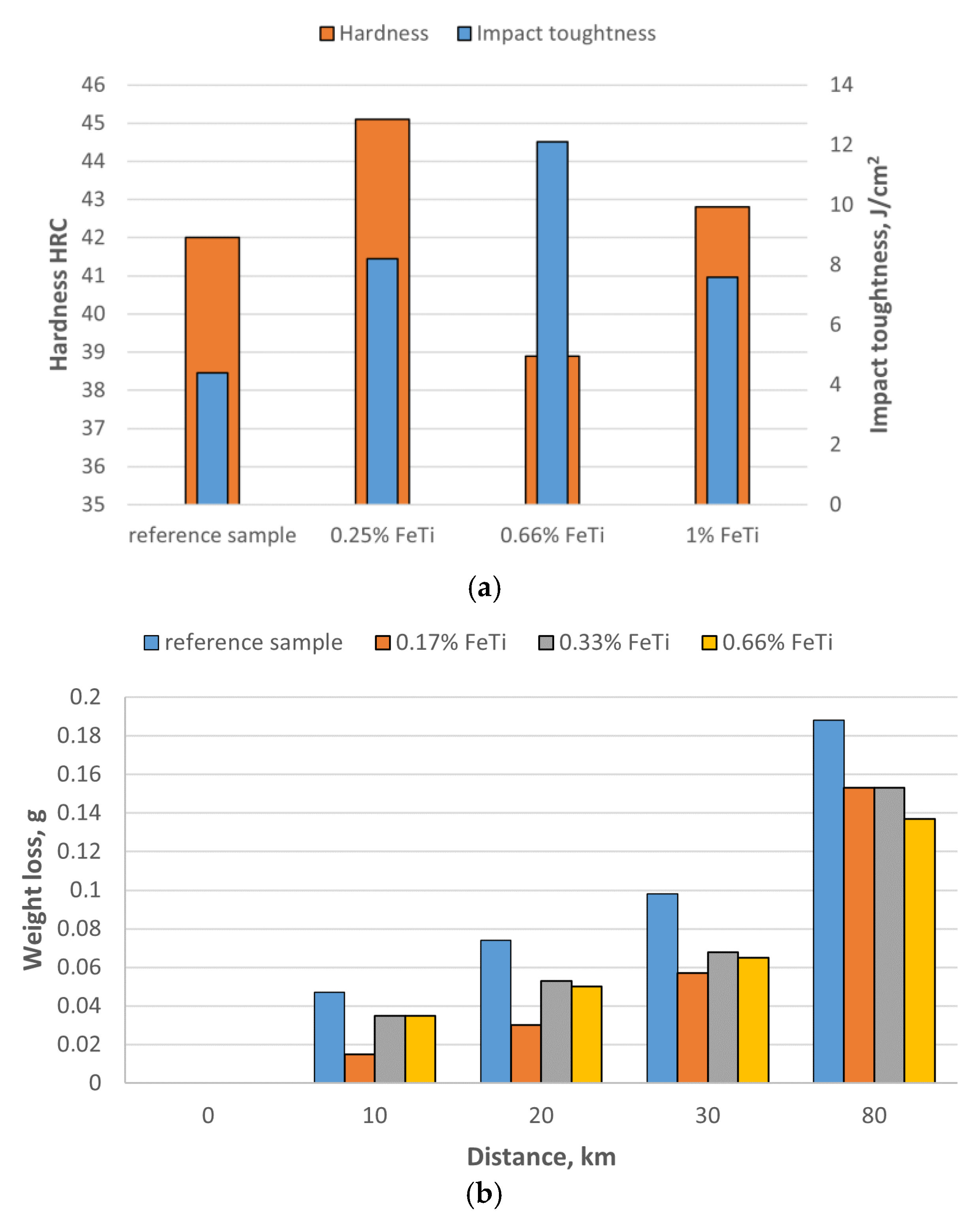
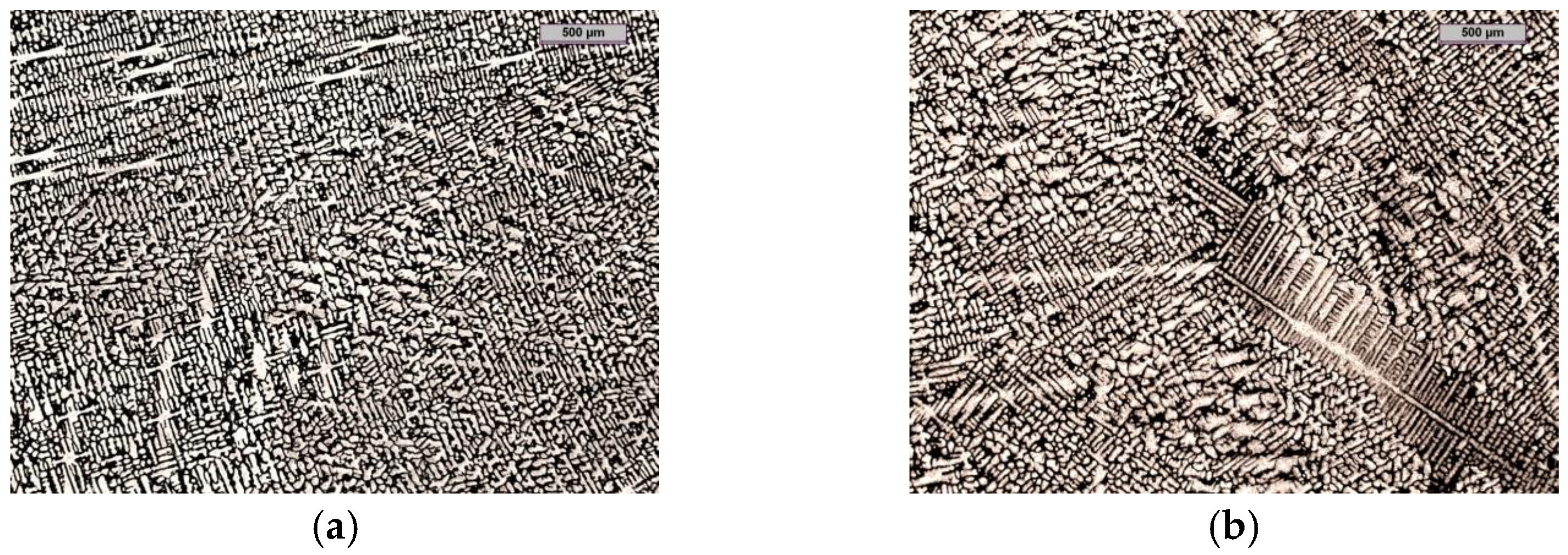
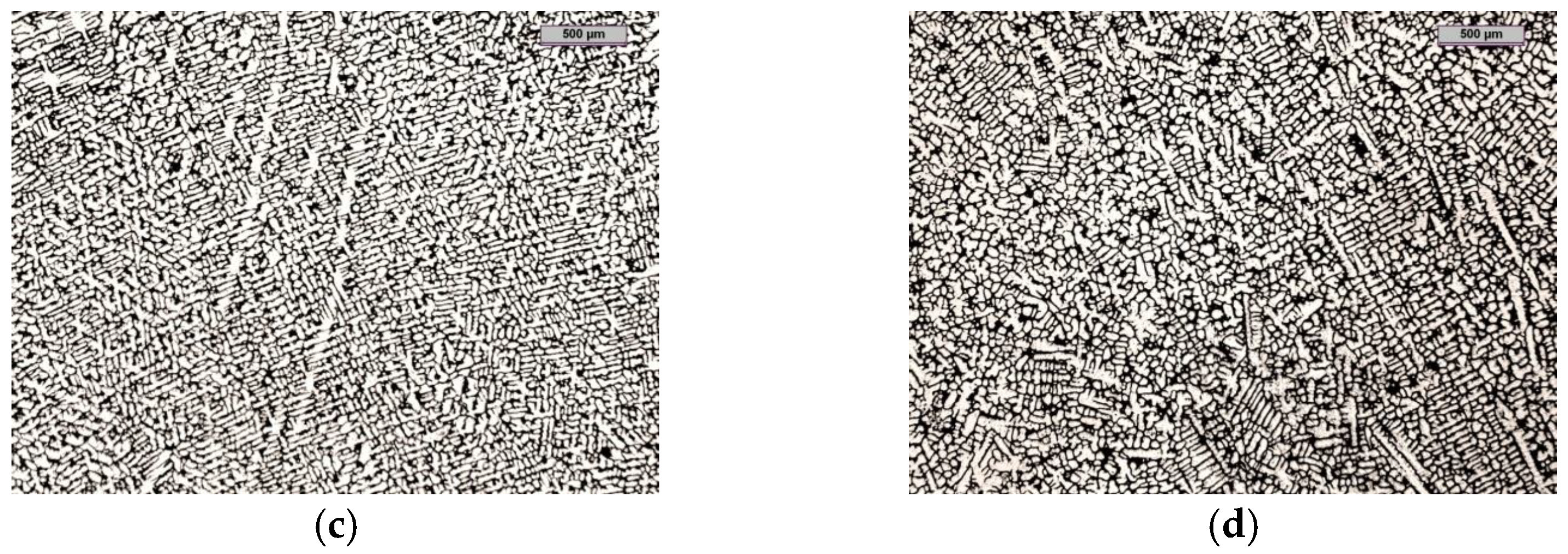
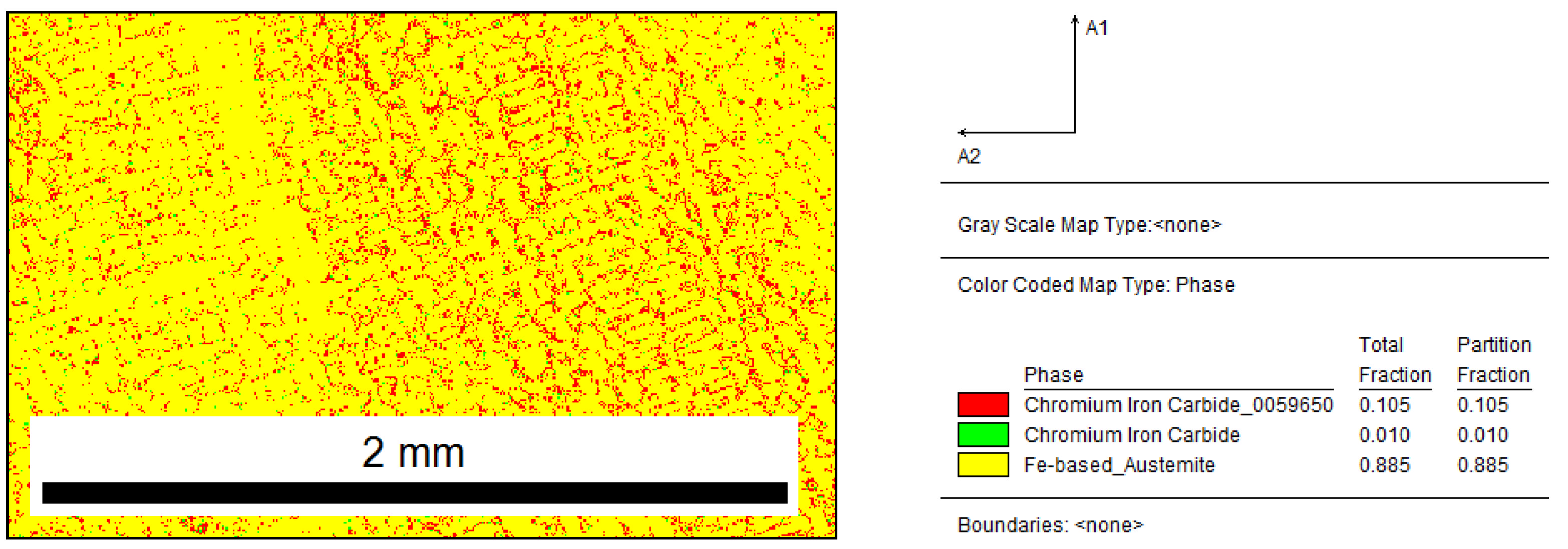
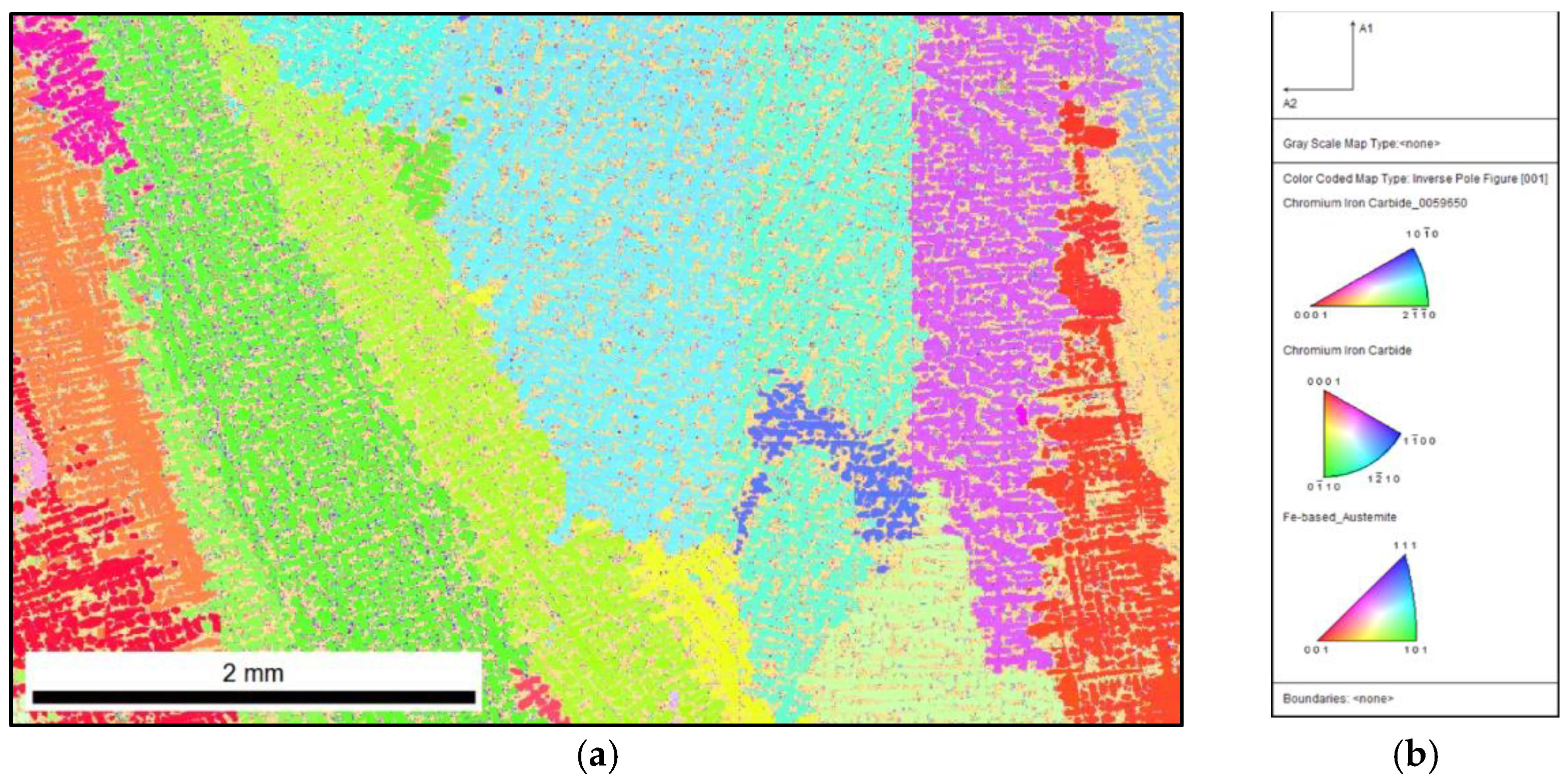

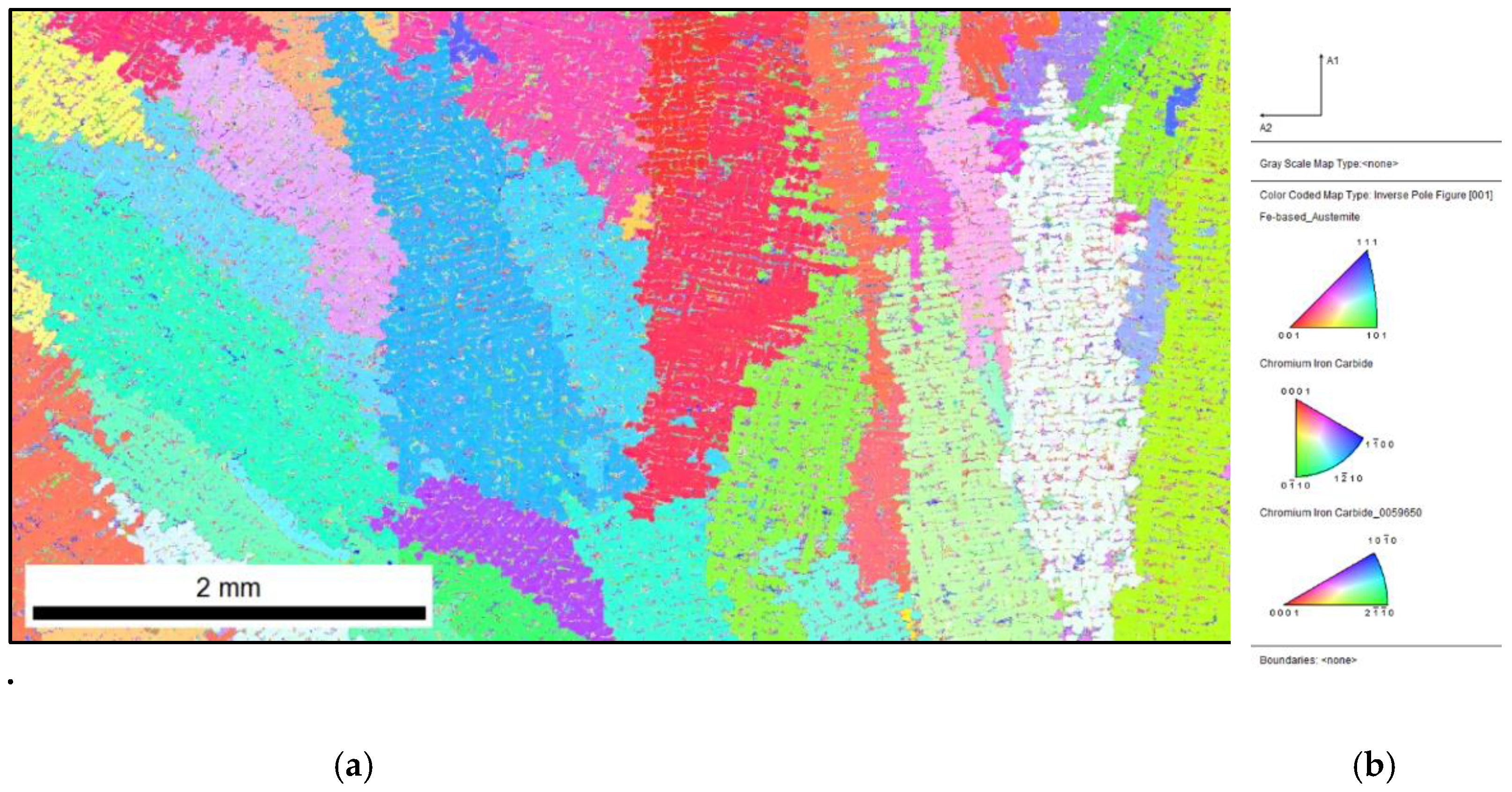
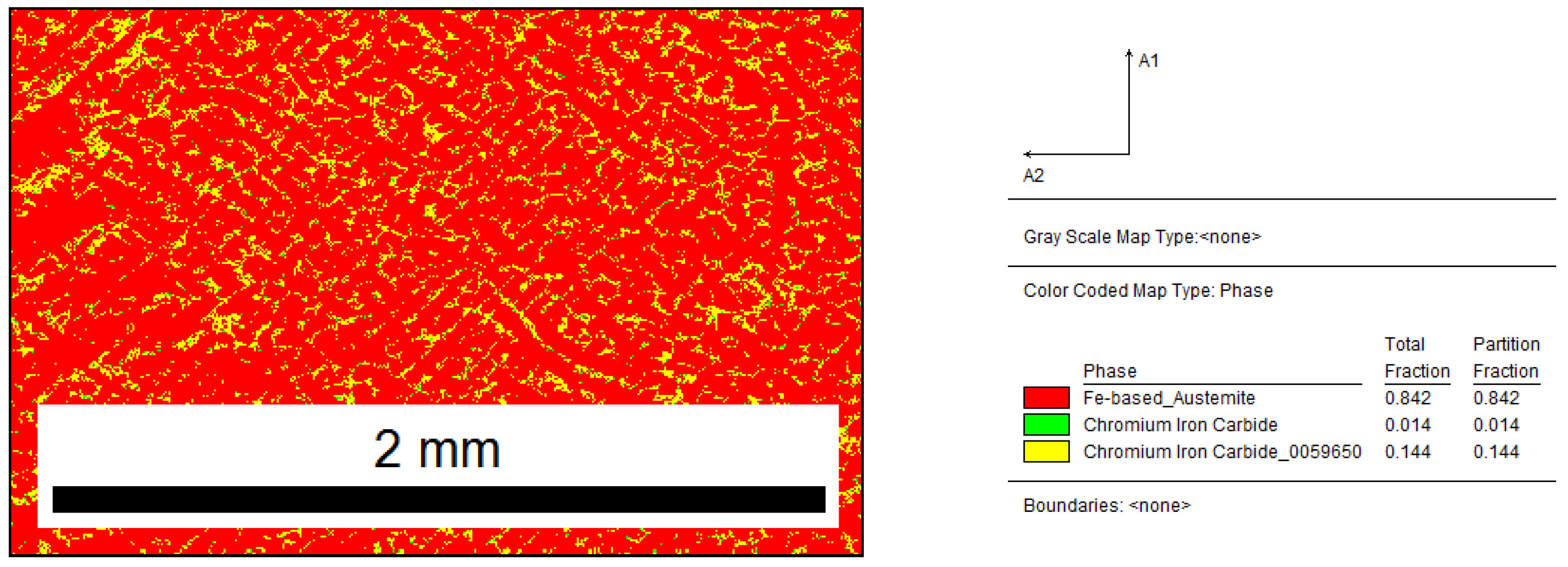
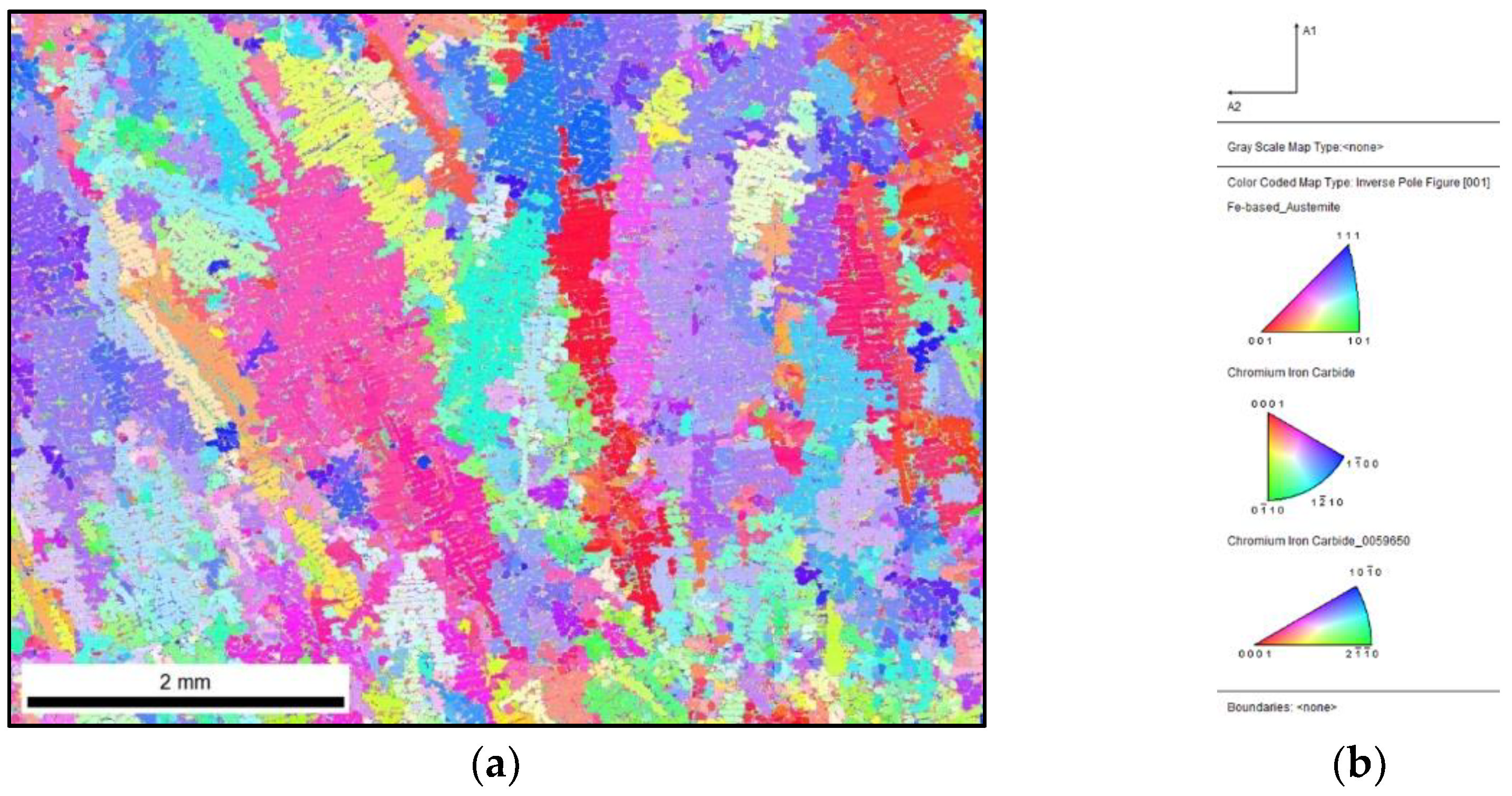
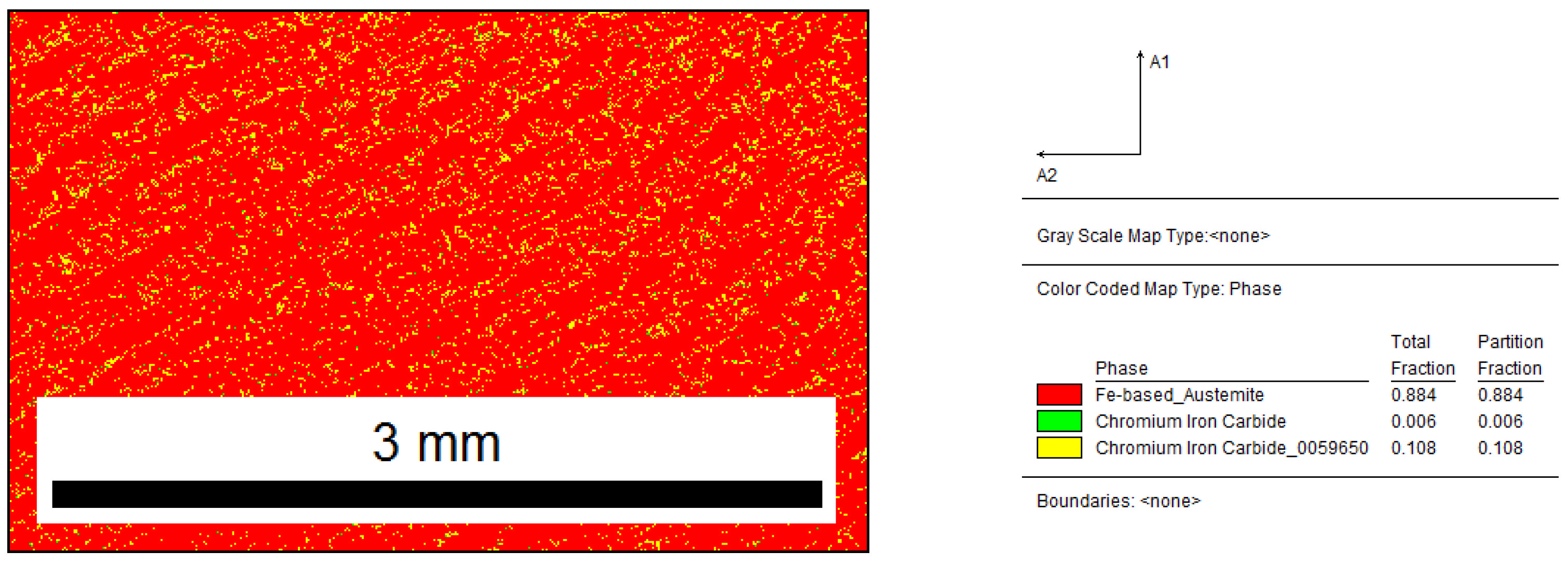
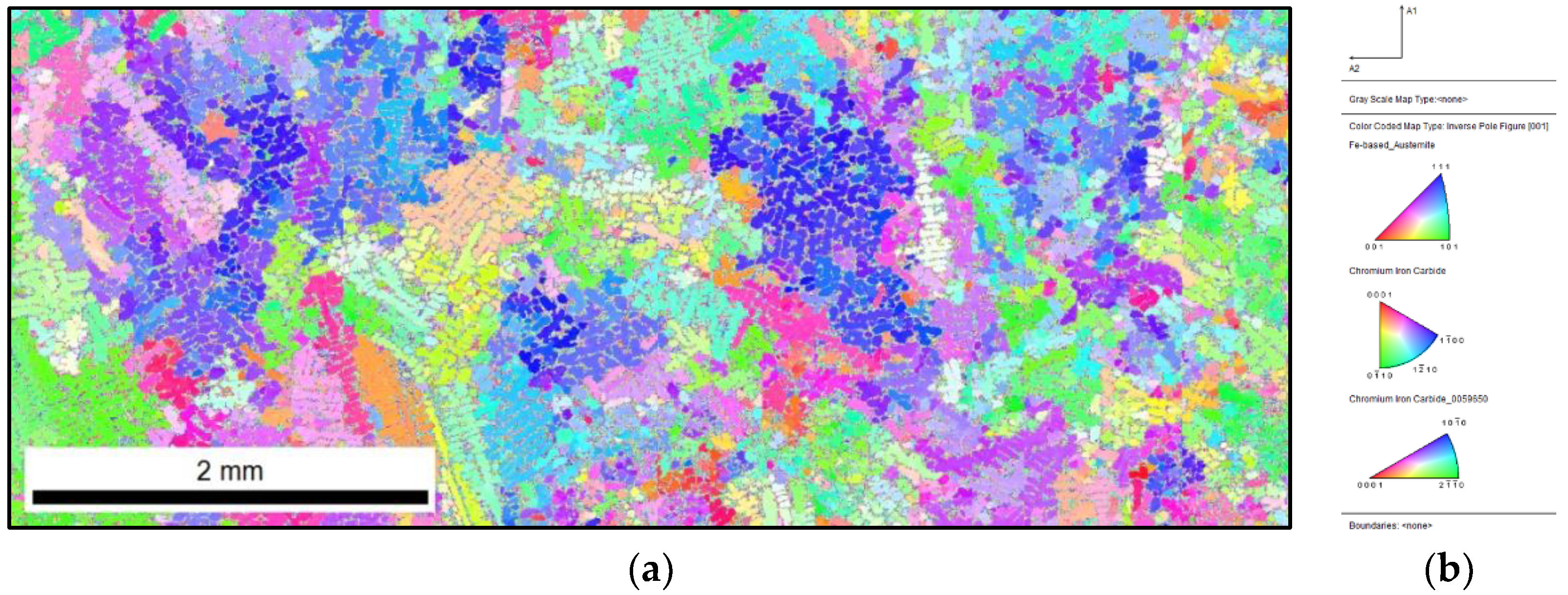
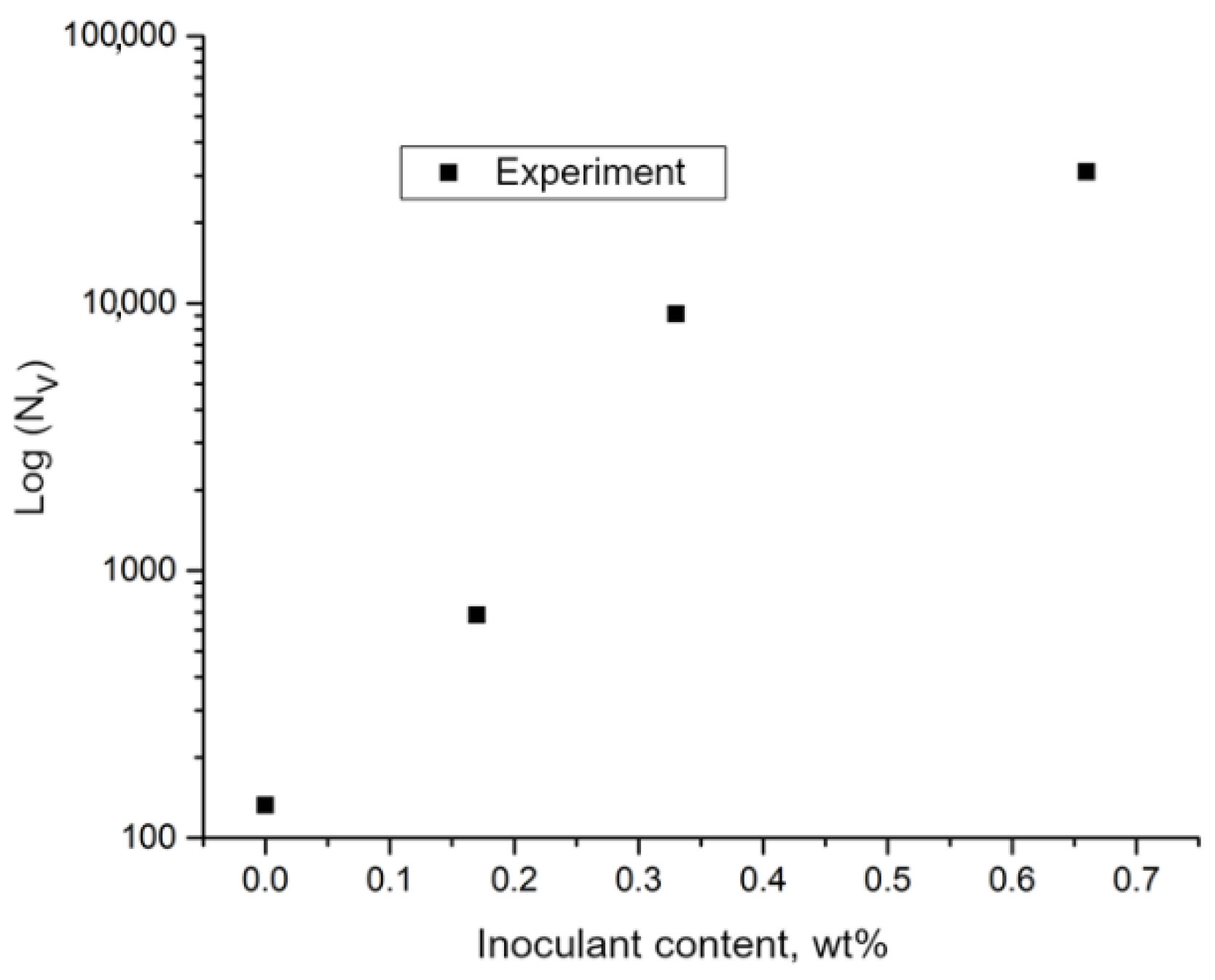
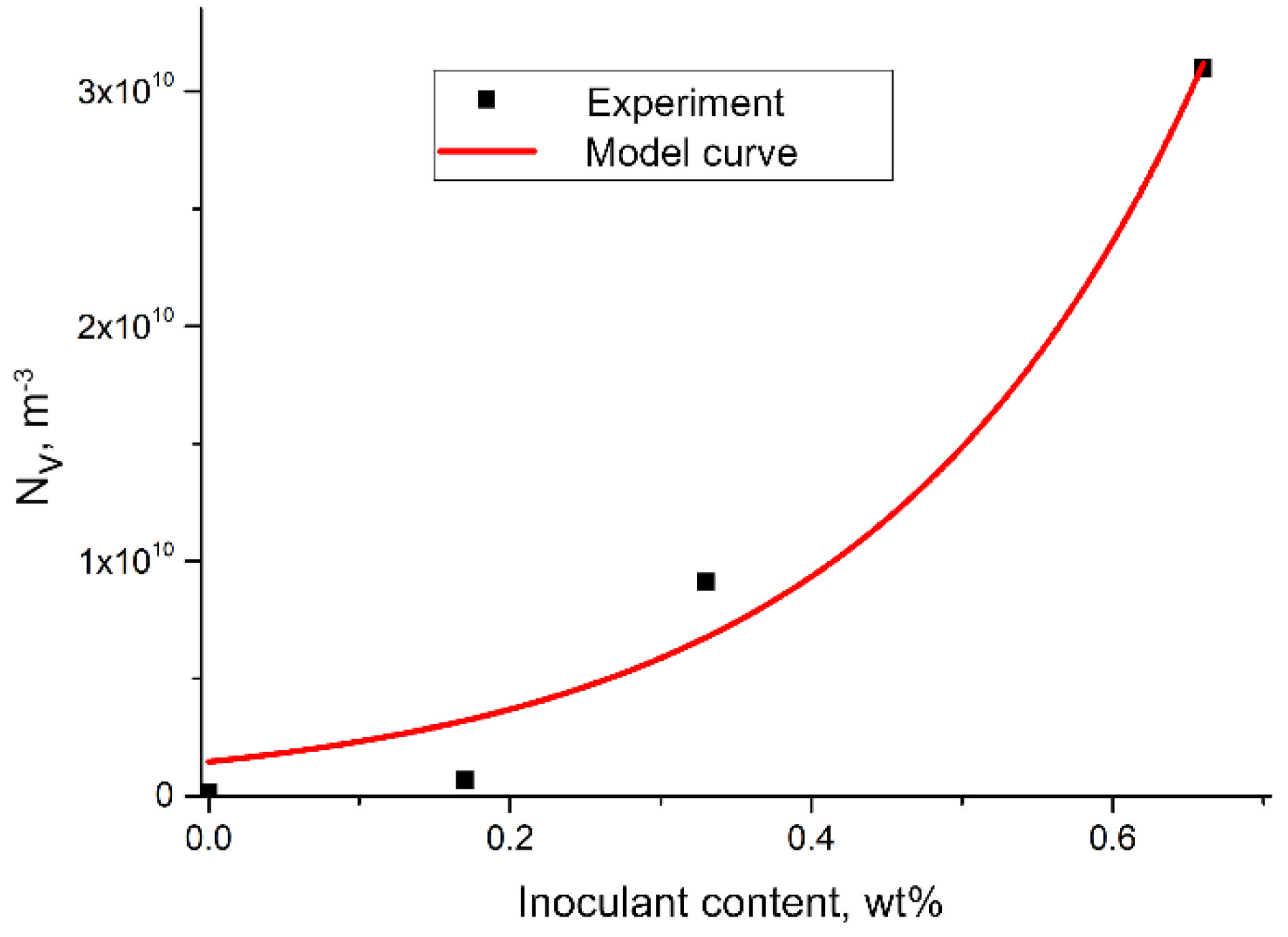
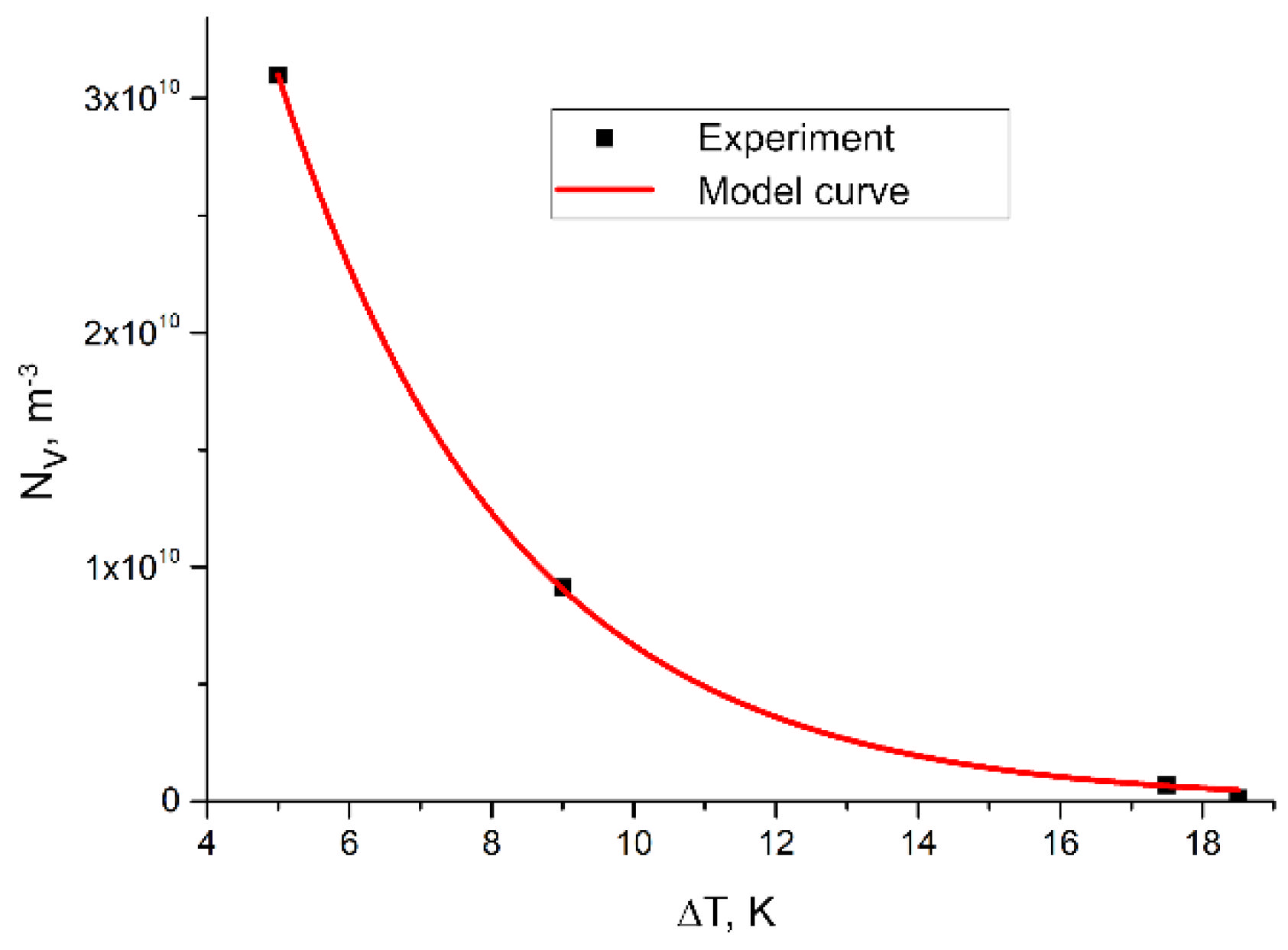
| Inoculant Addition | C | Si | Mn | P wt.% | S | Cr | Ti | ΔT K |
|---|---|---|---|---|---|---|---|---|
| +0.0% Fe–Ti | 1.81 | 0.77 | 0.47 | 0.02 | 0.01 | 21.19 | 0.0036 | 18.5 |
| +0.17% Fe–Ti | 1.78 | 0.79 | 0.47 | 0.02 | 0.01 | 21.21 | 0.0599 | 17.5 |
| +0.33% Fe–Ti | 1.77 | 0.77 | 0.42 | 0.02 | 0.01 | 21.21 | 0.0882 | 9.0 |
| +0.66% Fe–Ti | 1.67 | 0.77 | 0.43 | 0.02 | 0.01 | 21.06 | 0.2043 | 6.0 |
| Inoculant Addition | Impact Strength J/cm2 |
|---|---|
| +0.0% Fe–Ti | 4.4 |
| +0.17% Fe–Ti | 8.0 |
| +0.33% Fe–Ti | 14.0 |
| +0.66% Fe–Ti | 12.1 |
Publisher’s Note: MDPI stays neutral with regard to jurisdictional claims in published maps and institutional affiliations. |
© 2022 by the authors. Licensee MDPI, Basel, Switzerland. This article is an open access article distributed under the terms and conditions of the Creative Commons Attribution (CC BY) license (https://creativecommons.org/licenses/by/4.0/).
Share and Cite
Siekaniec, D.; Kopyciński, D.; Guzik, E.; Szczęsny, A. Effect of Inoculation Treatment on Number of Primary Austenite Grains in Hypoeutectic Chromium Cast Iron: EBSD Imaging and Mathematical Structure Prediction. Materials 2022, 15, 6318. https://doi.org/10.3390/ma15186318
Siekaniec D, Kopyciński D, Guzik E, Szczęsny A. Effect of Inoculation Treatment on Number of Primary Austenite Grains in Hypoeutectic Chromium Cast Iron: EBSD Imaging and Mathematical Structure Prediction. Materials. 2022; 15(18):6318. https://doi.org/10.3390/ma15186318
Chicago/Turabian StyleSiekaniec, Dorota, Dariusz Kopyciński, Edward Guzik, and Andrzej Szczęsny. 2022. "Effect of Inoculation Treatment on Number of Primary Austenite Grains in Hypoeutectic Chromium Cast Iron: EBSD Imaging and Mathematical Structure Prediction" Materials 15, no. 18: 6318. https://doi.org/10.3390/ma15186318
APA StyleSiekaniec, D., Kopyciński, D., Guzik, E., & Szczęsny, A. (2022). Effect of Inoculation Treatment on Number of Primary Austenite Grains in Hypoeutectic Chromium Cast Iron: EBSD Imaging and Mathematical Structure Prediction. Materials, 15(18), 6318. https://doi.org/10.3390/ma15186318







